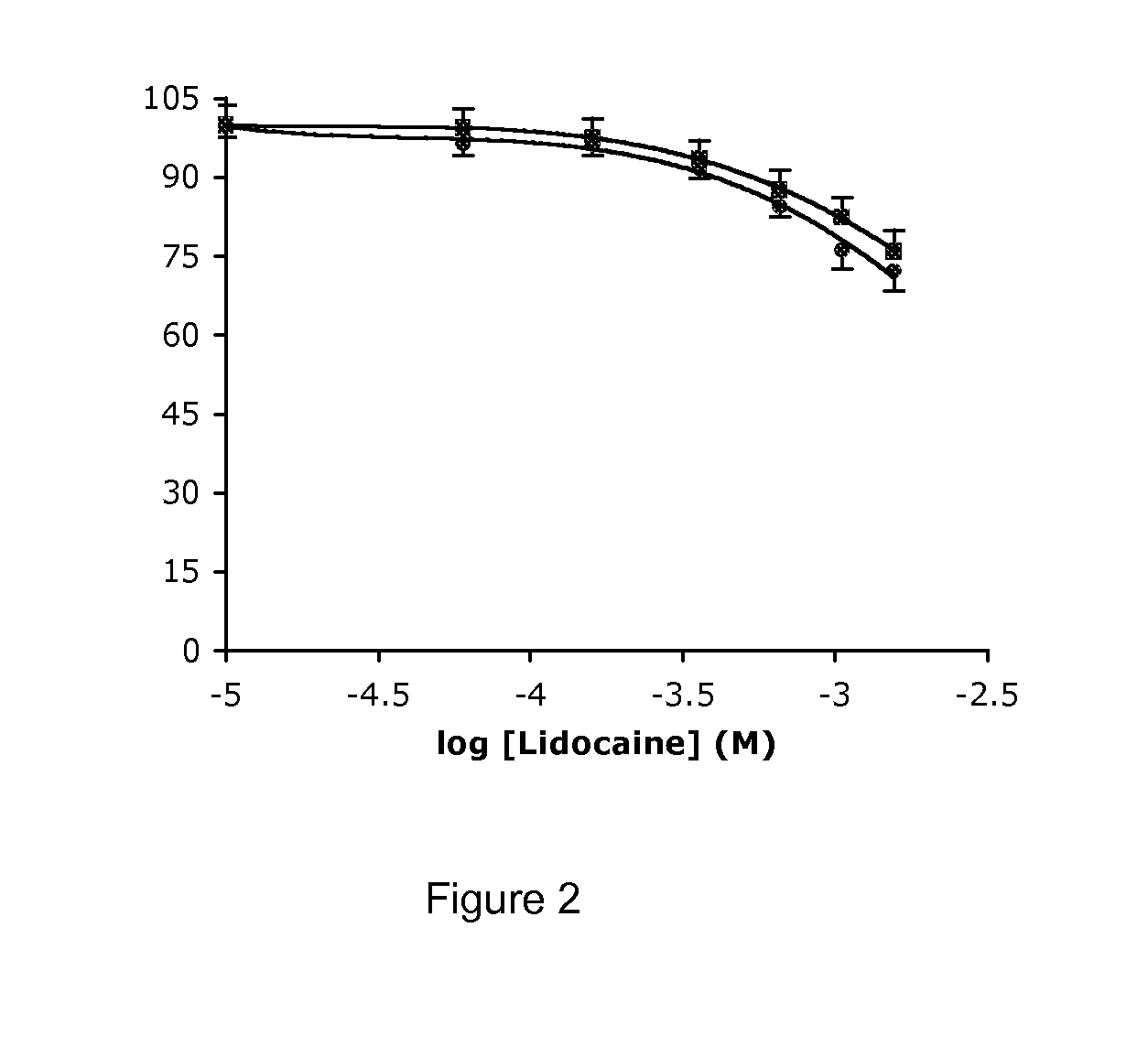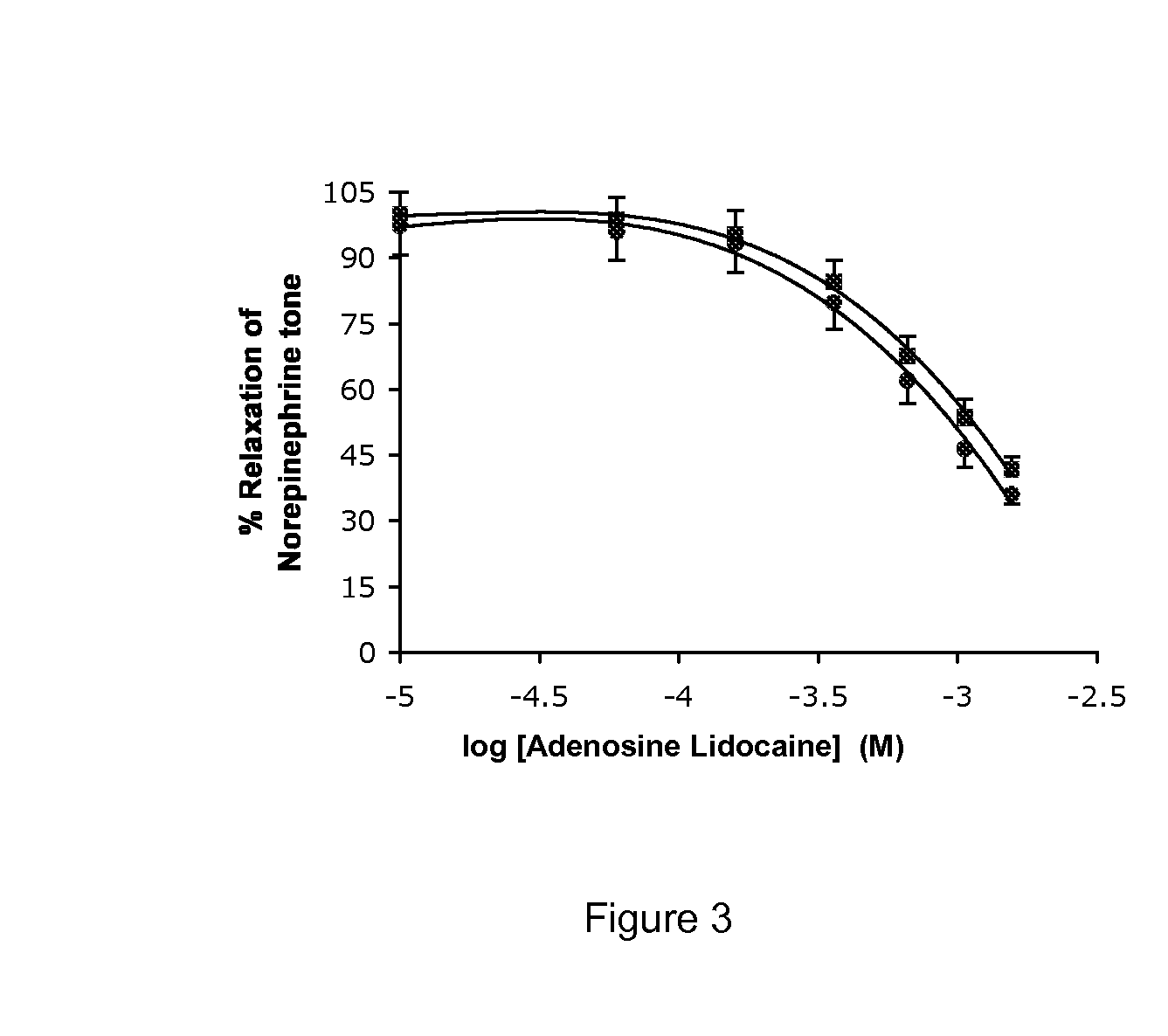Transplants
a technology of grafts and organs, applied in the field of transplants, can solve the problems of poor outcome, early graft occlusion rate of 20%, no therapy has proven clinically successful, and injury,
- Summary
- Abstract
- Description
- Claims
- Application Information
AI Technical Summary
Benefits of technology
Problems solved by technology
Method used
Image
Examples
example 1
Effect of Adenosine, Lidocaine and Adenosine Plus Lidocaine on Rat Aorta Muscle Tension and Relaxation
[0167]This example illustrates the different effect on intact isolated vasculature rings of an adenosine-lidocaine solution according to the invention, which did not lead to relaxation by over 5% until 200 uM. Adenosine and AL (adenosine and lidocaine) show similar effects, and about 30% greater falls in relaxation than lidocaine alone at 400 and 500 uM concentrations when bathed in 10 mM glucose in Krebs-Henseleit at pH 7.4 37° C. under aerobic conditions (95% O2 & 5% CO2). A major difference between AL and adenosine alone is that the AL-induced relaxation profile is not dependent on an intact endothelium. The effect of AL in the denuded rings is as if the endothelium is not removed.
[0168]Animal Preparation: Male Sprague Dawley rats (300-350 g) were fed ad libitum and housed in a 12-hour light / dark cycle. On the day of the experiment rats were anaesthetized using CO2 anaesthesia wh...
example 114
Effect of Increasing the Concentrations of Adenosine (10, 50, 100, 200, 300, 400 and 500 uM) on the Tension of Intact and Denuded Rat Aortic Rings Precontracted with Noradrenalin (FIG. 1)
[0195]The effect of increasing the concentrations of adenosine on the tension of intact and denuded rat aortic rings precontracted with norepinephrine are shown in FIG. 1a and Table 1. In intact rat aortic rings, the mean tension in the precontracted state was 3.68±0.11 g (n=6). Expressed as a percent of baseline (3.68 g), the tension values were 99, 96, 89, 76, 61, 48 and 39% for 10, 50, 100, 200, 300, 400 and 500 uM adenosine respectively (Table 1). Muscle tension did not begin to decrease by over 5% relative to the precontracted state until 100 uM adenosine with a relaxation of 10%. At 200, 300, 400 and 500 uM adenosine concentrations, the percent tension decrease was 24, 39, 52 and 61% respectively relative to the baseline norepinephrine precontracted state (Table 2). In denuded aortic rings, th...
example 1b
Effect of Increasing the Concentrations of Lidocaine on the Tension of Intact and Denuded Rat Aortic Rings Precontracted with Noradrenalin (FIG. 2)
[0203]The effect of increasing the concentrations of lidocaine on the tension of intact and denuded rat aortic rings precontracted with norepinephrine are shown in FIG. 2 and Table 1. The mean tension for intact rings in the precontracted state 3.58±0.07 g (n=6) (Table 1). Expressed as a percent of baseline, tension values were 100, 96, 96, 91, 84, 76 and 72% for 10, 50, 100, 200, 300, 400 and 500 uM lidocaine respectively (Table 1). Muscle tension did not begin to decrease by over 5% relative to the precontracted state until 200 uM lidocaine with a relaxation of 9% and at 300, 400 and 500 uM lidocaine concentrations, the percent tension decrease was 16, 24 and 28% respectively relative to baseline. This tension relaxation profile for lidocaine in intact rings was similar to adenosine alone in denuded rings (ie for adenosine denuded rings...
PUM
| Property | Measurement | Unit |
|---|---|---|
| time | aaaaa | aaaaa |
| half life | aaaaa | aaaaa |
| concentration | aaaaa | aaaaa |
Abstract
Description
Claims
Application Information
 Login to View More
Login to View More - R&D
- Intellectual Property
- Life Sciences
- Materials
- Tech Scout
- Unparalleled Data Quality
- Higher Quality Content
- 60% Fewer Hallucinations
Browse by: Latest US Patents, China's latest patents, Technical Efficacy Thesaurus, Application Domain, Technology Topic, Popular Technical Reports.
© 2025 PatSnap. All rights reserved.Legal|Privacy policy|Modern Slavery Act Transparency Statement|Sitemap|About US| Contact US: help@patsnap.com



